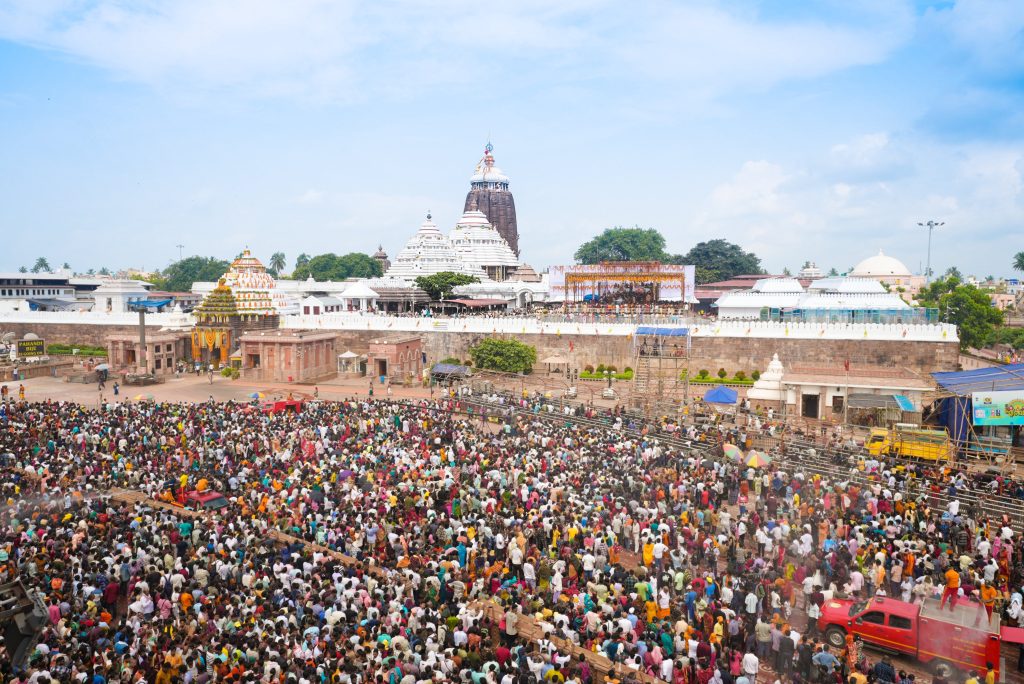Puri: On this auspicious Wednesday, a sea of devotees, estimated to be in the lakhs, thronged the holy city of Puri to partake in the sacred Deva Snana Purnima, the ceremonial bathing ritual of Lord Jagannath, Lord Balabhadra, and Devi Subhadra. The air was thick with devotion, reverberating with chants and hymns as the divine spectacle unfolded in an open pandal on the revered premises of the 12th-century Shree Jagannath Temple.
Among the distinguished attendees were Chief Minister Mohan Charan Majhi and Puri MP Sambit Patra, who arrived together, entering through the ‘Uttara Dwara’ (northern gate). They witnessed the solemn morning prayers and the grand ‘Pahandi’ (procession) as the deities were meticulously brought from the sanctum sanctorum to the ‘Snana Mandap’ (bathing altar). The Chief Minister, in his first significant visit to the temple since assuming office, expressed his profound reverence and spoke of the spiritual significance of the occasion for the people of Odisha and beyond.
The ‘Pahandi ritual’ commenced early, with Shree Sudarshan leading the procession at 5:45 AM, followed by Lord Balabhadra, Devi Subhadra, and finally, Lord Jagannath. The meticulous and rhythmic movement of the deities, swayed by the Daita servitors, was a sight to behold, evoking deep emotional responses from the eager crowd. The entire procession was completed by 8:55 AM, marking the beginning of the central bathing rituals.
Deba Snana Purnima, celebrated on the full moon day of the Jyestha month, holds immense religious significance. It is the sole occasion in a year when the beloved wooden idols of the deities are brought out of the sanctum sanctorum for a public bathing ceremony. It is also popularly celebrated as the birthday of Lord Jagannath.
As the morning progressed, Vedic mantras filled the atmosphere, and the much-anticipated bathing ceremony began around 12:20 PM. A total of 108 pitchers of ‘sacred water,’ meticulously drawn from the ‘Sunakua’ (golden well) located within the temple premises, were poured over the divine forms, symbolizing purification and celestial blessings. The water, imbued with the essence of various herbs and fragrant flowers, cascaded over the deities, signifying a ritualistic cleansing that prepares them for their subsequent period of convalescence.
Following the elaborate bathing, Puri’s titular king, Gajapati Maharaj Dibyasingha Deb, performed the ceremonial sweeping of the ‘Snana Mandap’, a tradition steeped in history and humility. Soon after, the deities were adorned in the magnificent ‘Gaja Vesha’ (attire of the elephant God), transforming their appearance into a majestic and awe-inspiring form, further captivating the devotees. This unique attire is believed to bestow prosperity and good fortune upon those who witness it.

Later in the afternoon, ‘Sahan Mela’ or public darshan was permitted, allowing devotees to have a closer glimpse of the deities in their splendid ‘Gaja Vesha’ before they retreat.
The Divine Illness and Retreat to Anasara Ghar
The culmination of the bathing rituals marks the beginning of a unique phase for the deities. After the elaborate bath, it is believed that the deities fall ill and are subsequently moved to the ‘Anasara Ghar’ (isolation room) within the temple. For a period of 14 days, they remain in this secluded chamber, away from public view. During this time, the temple ‘Baidya’ (physician) attends to them, administering herbal medicines and providing special care.
This period of ‘Anasara’ signifies the divine convalescence, a time of rest and recovery before their grand reappearance. Public ‘darshan’ of the deities will remain closed until ‘Nabajouban Darshan’ on June 26, which is just a day prior to the world-renowned annual Rath Yatra on June 27. The ‘Nabajouban Darshan’ marks the deities’ return to full health and vigor, ready to embark on their annual chariot journey, blessing millions.
Enhanced Security and Modern Surveillance for the Sacred Event
Given the immense congregation of devotees, security measures in Puri were significantly heightened. SP Vinit Agarwal confirmed the deployment of 70 platoons (each comprising 30 personnel) of force and 450 officers to ensure the smooth conduct of the festival. “We expect a congregation of lakhs of devotees on the day and have made elaborate arrangements for crowd management, traffic regulation, and ground control. The forces are deployed inside and outside the temple and at the seaside,” the SP stated. Barricades were strategically erected to manage the flow of devotees and ensure their smooth movement during the ceremonial bathing.
In a first, the Puri police leveraged advanced technology for enhanced surveillance. “For the first time, the police are using AI-based surveillance cameras, linked to a new integrated control room, for real-time monitoring,” SP Shri Agarwal added, highlighting the commitment to ensuring both spiritual devotion and public safety during this grand celebration. The integration of technology underscored the meticulous planning behind managing an event of such massive scale and profound religious significance.


